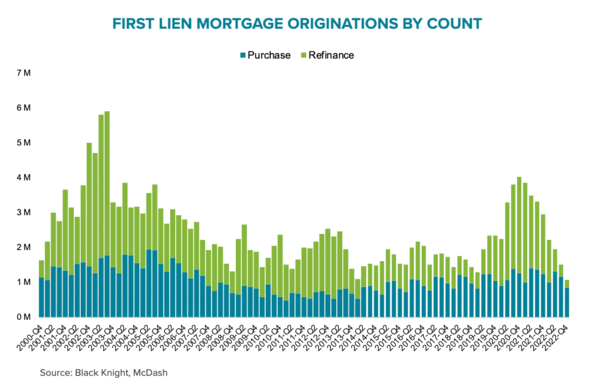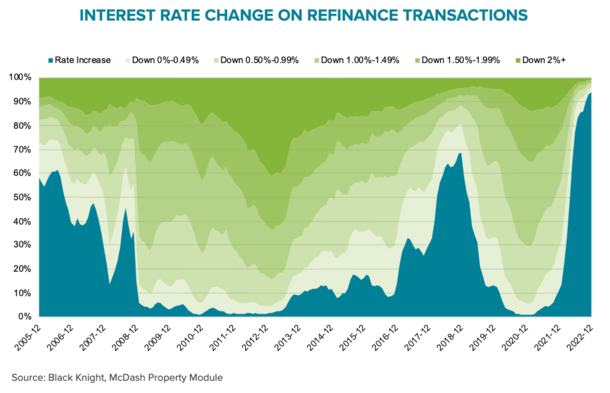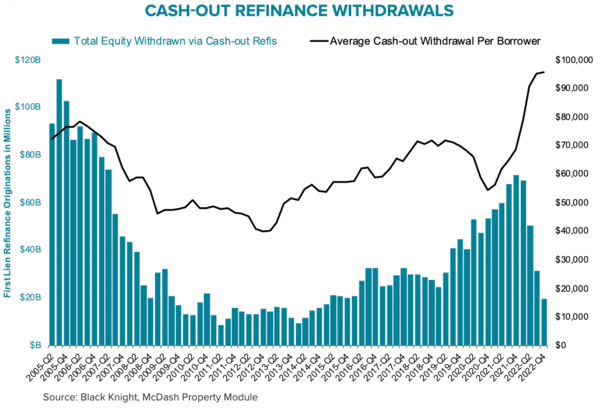Typically, borrowers refinance their home loans to take advantage of lower mortgage rates.
But recently, the average refinance has resulted in an interest rate 2.4% higher than the rate prior to the transaction.
As to why, it’s mostly because the only homeowners refinancing these days are doing so to tap equity.
The last time we saw a similar phenomenon was in 2018, when roughly 70% of refinances involved an interest rate increase.
Back then, borrowers saw an average rate increase of 0.4%. What’s going on?
Rate and Term Refinancing Hits an All-Time Low

A new report from Black Knight revealed that 96% of the 216,000 mortgage refinances completed in the fourth quarter of 2022 were cash-out loans, the highest quarterly share on record.
Meanwhile, there were less than 10,000 rate and term refinances, the lowest on record.
Prior to Q4 2022, the lowest quarterly total was 76,000 in 2018. The average has been 650,000 per quarter going back 15 years.
And in the first quarter of 2021 alone, there were 1.8 million rate/term refis, 190 times the Q4 2022 total.
For all of 2022, 1.98 million cash out refinances were completed, accounting for more than 80% of all refinances for the year.
In other words, the refinance market has been dominated by cash out refinances, which makes total sense.
With mortgage rates close to 7%, there’s very little reason to refinance unless you’re tapping home equity.
The only other reason, other than say removing someone from an existing loan, would be to switch from an adjustable-rate mortgage to a fixed-rate loan.
But those situations appeared to be few and far between.
The 216,000 refinances in the fourth quarter of 2022 (including 62K in December) were also both all-time lows.
And the 863,000 purchase mortgage originations were the lowest since 2015, pushing overall quarterly mortgage volume to its lowest point on record (dating back to 2000).
The Average Mortgage Refinance Led to an Interest Rate 2.4% Higher

Black Knight noted that cash-out refinance volume has also fallen of late, but should “make up the lion’s share of refinance lending in early 2023 as well.”
What’s pretty wild is 94% of those who refinanced this past December raised their interest rate in the process.
And the typical refinance resulted in a 2.4 percentage point increase in the borrowers’ interest rate!
For example, a borrower may have had a rate of 3.5% before the refinance, and now has a rate of 5.875%.
Of course, if they need the cash, they need the cash. And while an interest rate of near-6% isn’t as favorable as 3.5%, it likely beats rates on all other types of loans.
So the cash-out proceeds could still be used to extinguish other debts with much higher interest rates, possibly in the double-digits.
For perspective, the average borrower who refinanced in early 2021 received a mortgage rate reduction of 1.3% on average.
As seen in the chart above, mortgage rate increases post-refinance were also common in 2005-2008.
Back then, there were a lot of cash out refinances too. And borrowers were often serially refinancing to cover discretionary purchases.
Quarterly Cash Out Volume Lowest Since 2015

Despite cash out refis leading the way, just $19 billion in equity was withdrawn during the fourth quarter, the lowest total since early 2015.
And cash-out withdrawals equaled a mere 0.2% of tappable equity entering the quarter, the lowest on record.
In other words, there’s a ton of home equity out there that has been left untapped.
This contrasts 2006-2008, when homeowners tapped every penny possible via 100% CLTV cash out refinances.
However, the average amount of equity being withdrawn surged from less than $55,000 in late 2020 to more than $95,000 recently.
So those who are cashing out are pulling more money out.
But the average unpaid balance (pre-equity extraction) of these borrowers decreased from around $240,000 in early 2020 to $165,000 in the fourth quarter.
This means those with small existing home loan balances in need of lots of cash are going the cash out refinance route.
Meanwhile, those with large existing home loan balances are opting to keep their low mortgage rate intact and tap equity via a second mortgage.
By choosing to extract equity via a home equity loan or HELOC, they can hold onto their low, fixed-rate mortgage for years to come.
As for the homeowners increasing their mortgage rates, they could possibly benefit from a refinance in the near future if rates trend back down to 4-5%.


